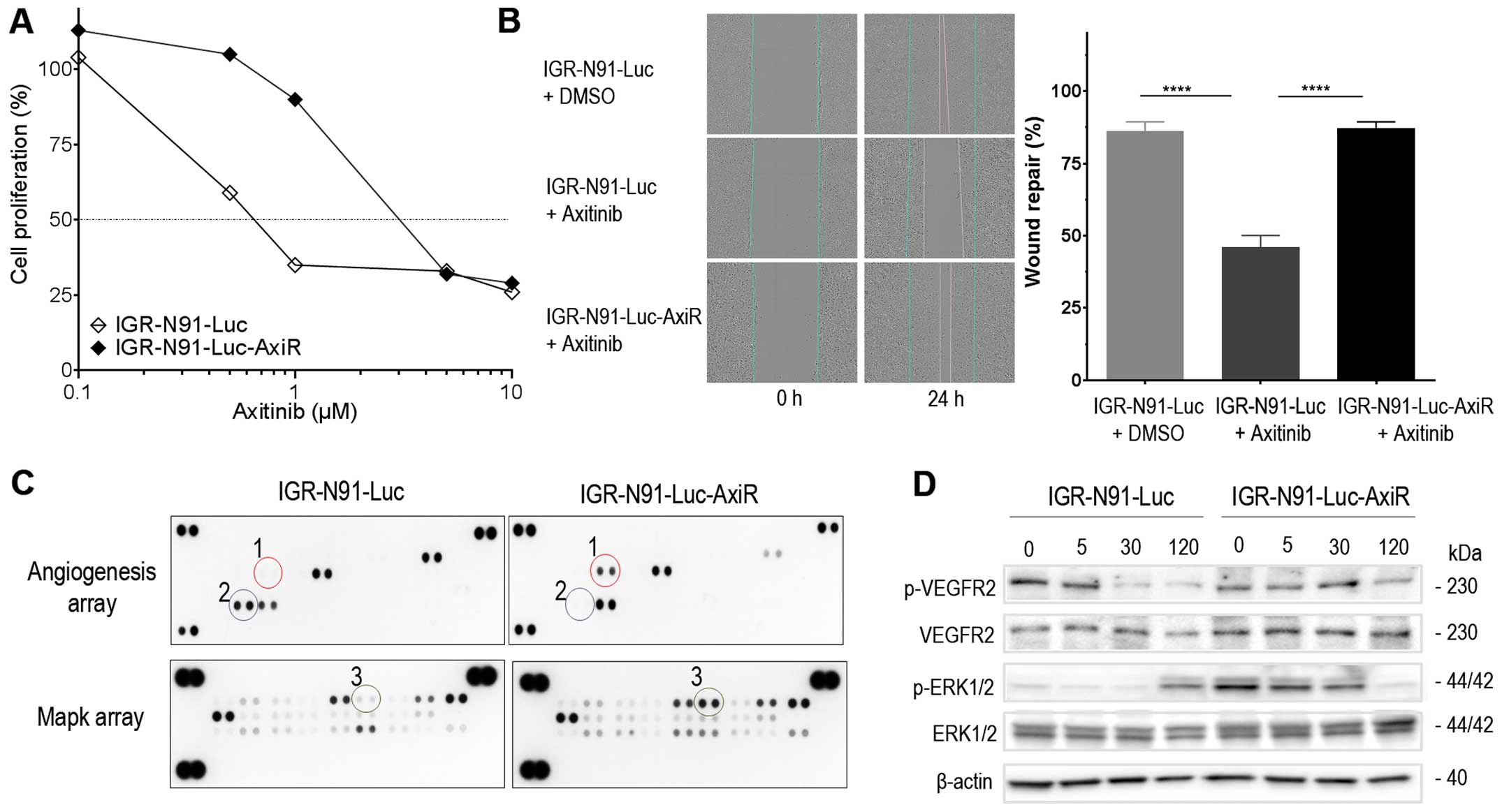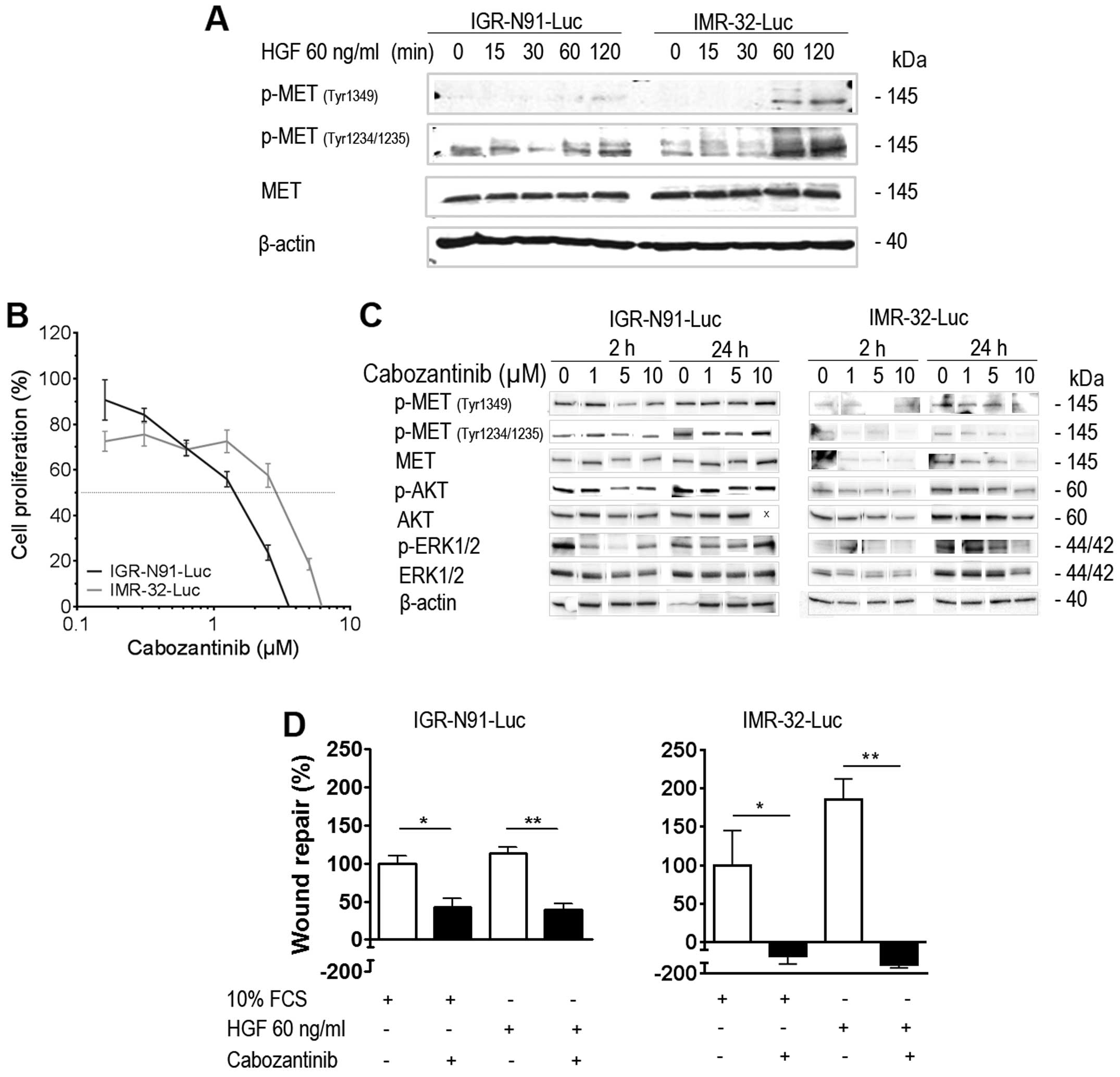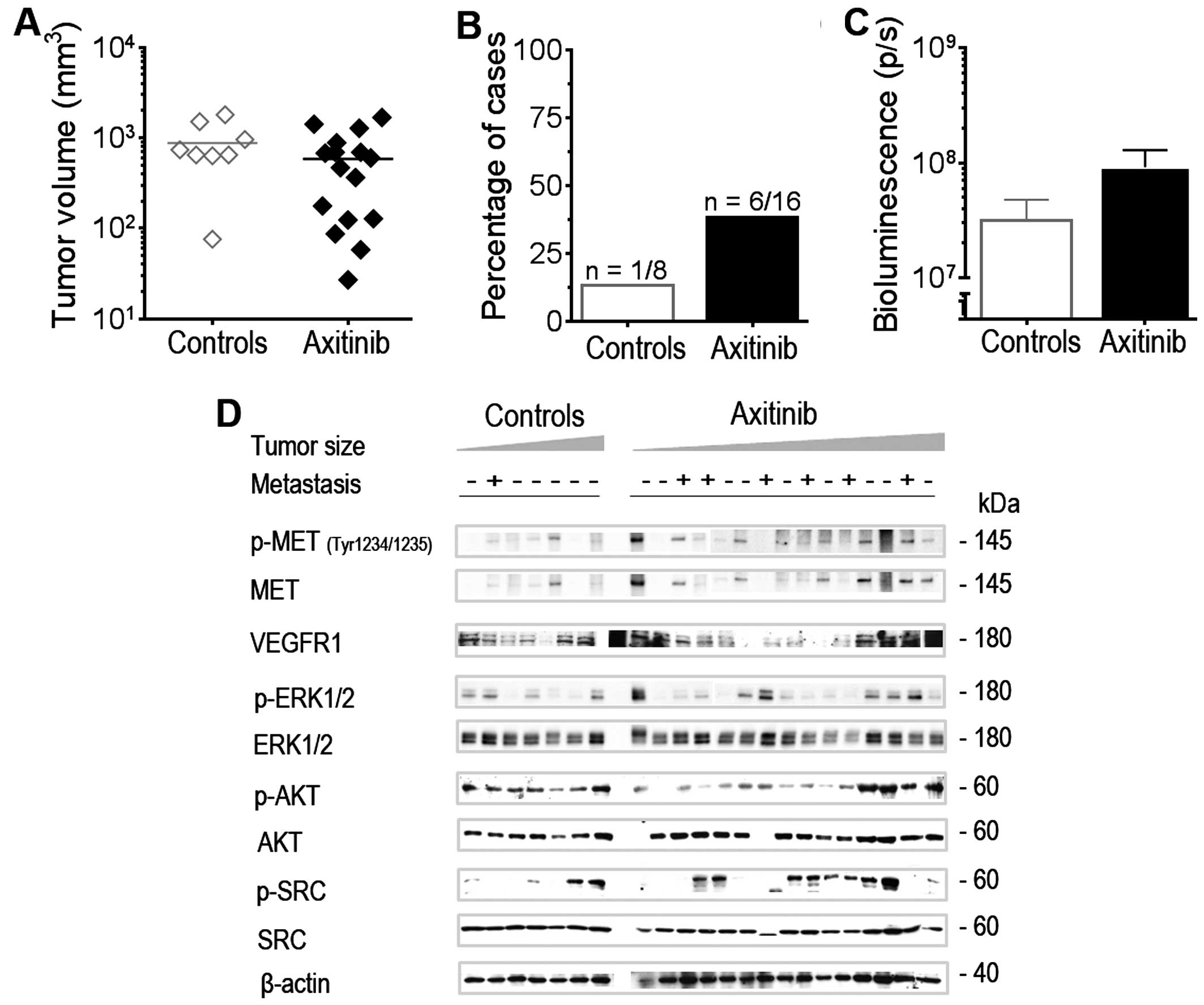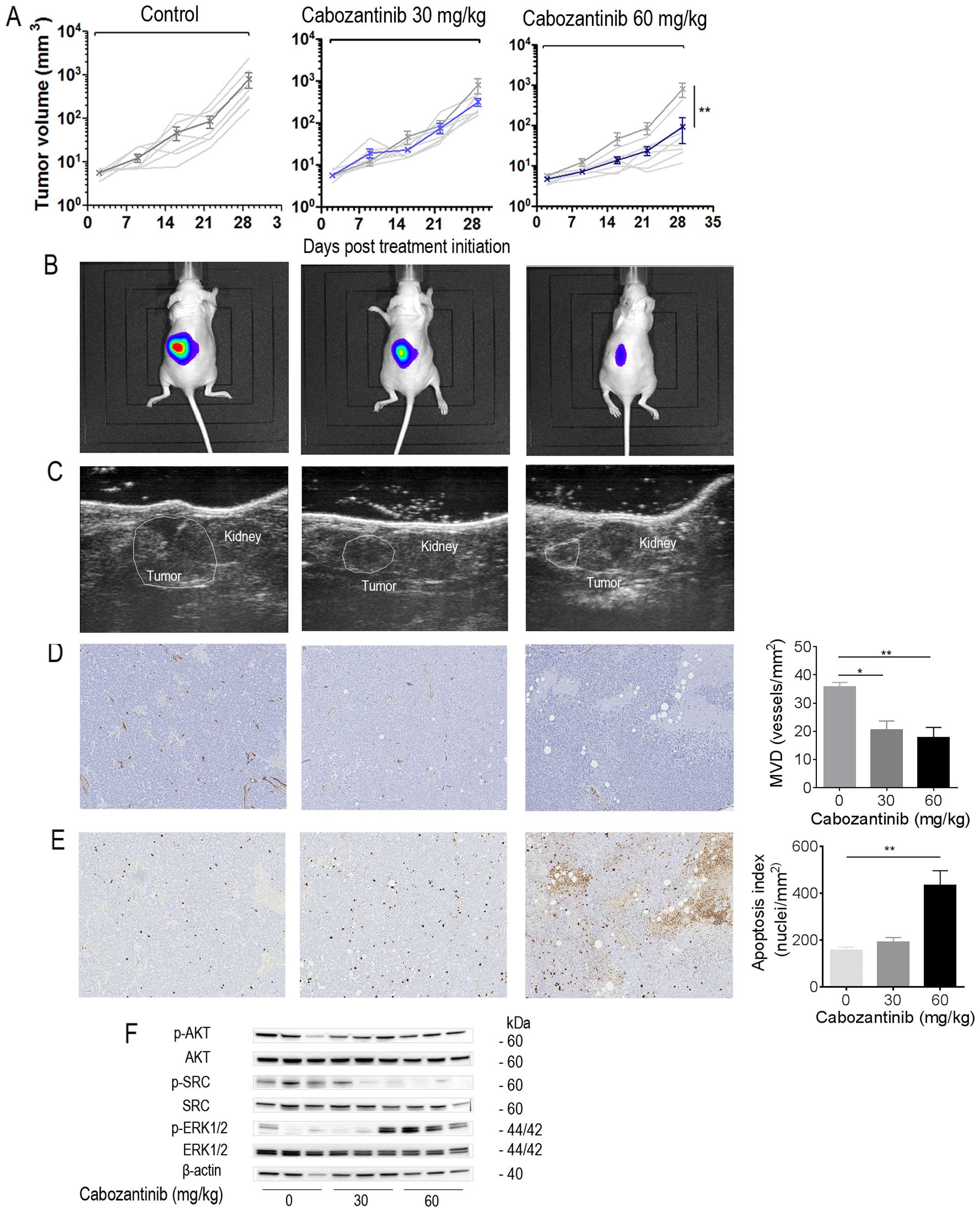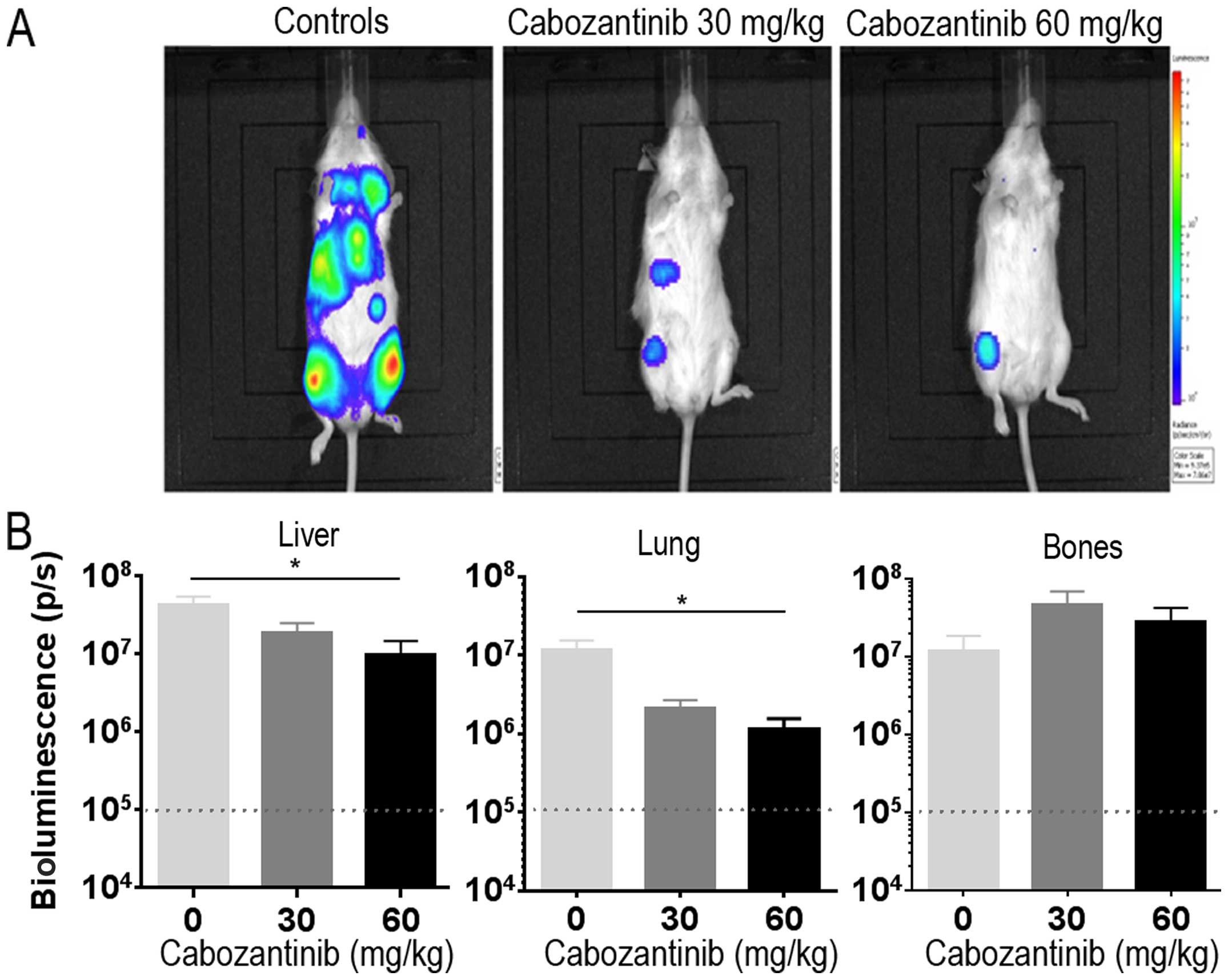|
1
|
Birchmeier C and Gherardi E: Developmental
roles of HGF/SF and its receptor, the c-Met tyrosine kinase. Trends
Cell Biol. 8:404–410. 1998. View Article : Google Scholar : PubMed/NCBI
|
|
2
|
Grant DS, Kleinman HK, Goldberg ID,
Bhargava MM, Nickoloff BJ, Kinsella JL, Polverini P and Rosen EM:
Scatter factor induces blood vessel formation in vivo. Proc Natl
Acad Sci USA. 90:1937–1941. 1993. View Article : Google Scholar : PubMed/NCBI
|
|
3
|
Zhang L, Yang N, Park JW, Katsaros D,
Fracchioli S, Cao G, O'Brien-Jenkins A, Randall TC, Rubin SC and
Coukos G: Tumor-derived vascular endothelial growth factor
up-regulates angiopoietin-2 in host endothelium and destabilizes
host vasculature, supporting angiogenesis in ovarian cancer. Cancer
Res. 63:3403–3412. 2003.PubMed/NCBI
|
|
4
|
Sulpice E, Ding S, Muscatelli-Groux B,
Bergé M, Han ZC, Plouet J, Tobelem G and Merkulova-Rainon T:
Cross-talk between the VEGF-A and HGF signalling pathways in
endothe-lial cells. Biol Cell. 101:525–539. 2009. View Article : Google Scholar : PubMed/NCBI
|
|
5
|
Dong G, Chen Z, Li ZY, Yeh NT, Bancroft CC
and Van Waes C: Hepatocyte growth factor/scatter factor-induced
activation of MEK and PI3K signal pathways contributes to
expression of proangiogenic cytokines interleukin-8 and vascular
endothelial growth factor in head and neck squamous cell carcinoma.
Cancer Res. 61:5911–5918. 2001.PubMed/NCBI
|
|
6
|
Dong G, Lee TL, Yeh NT, Geoghegan J, Van
Waes C and Chen Z: Metastatic squamous cell carcinoma cells that
overexpress c-Met exhibit enhanced angiogenesis factor expression,
scattering and metastasis in response to hepatocyte growth factor.
Oncogene. 23:6199–6208. 2004. View Article : Google Scholar : PubMed/NCBI
|
|
7
|
Abounader R, Lal B, Luddy C, Koe G,
Davidson B, Rosen EM and Laterra J: In vivo targeting of SF/HGF and
c-met expression via U1snRNA/ribozymes inhibits glioma growth and
angiogenesis and promotes apoptosis. FASEB J. 16:108–110. 2002.
|
|
8
|
Abounader R and Laterra J: Scatter
factor/hepatocyte growth factor in brain tumor growth and
angiogenesis. Neuro Oncol. 7:436–451. 2005. View Article : Google Scholar : PubMed/NCBI
|
|
9
|
Goyal L, Muzumdar MD and Zhu AX: Targeting
the HGF/c-MET pathway in hepatocellular carcinoma. Clin Cancer Res.
19:2310–2318. 2013. View Article : Google Scholar : PubMed/NCBI
|
|
10
|
Kawakami H, Okamoto I, Okamoto W, Tanizaki
J, Nakagawa K and Nishio K: Targeting MET amplification as a new
oncogenic driver. Cancers (Basel). 6:1540–1552. 2014. View Article : Google Scholar
|
|
11
|
Sköldenberg EG, Larsson A, Jakobson A,
Hedborg F, Kogner P, Christofferson RH and Azarbayjani F: The
angiogenic growth factors HGF and VEGF in serum and plasma from
neuroblastoma patients. Anticancer Res. 29:3311–3319.
2009.PubMed/NCBI
|
|
12
|
Hecht M, Schulte JH, Eggert A, Wilting J
and Schweigerer L: The neurotrophin receptor TrkB cooperates with
c-Met in enhancing neuroblastoma invasiveness. Carcinogenesis.
26:2105–2115. 2005. View Article : Google Scholar : PubMed/NCBI
|
|
13
|
Hecht M, Papoutsi M, Tran HD, Wilting J
and Schweigerer L: Hepatocyte growth factor/c-Met signaling
promotes the progression of experimental human neuroblastomas.
Cancer Res. 64:6109–6118. 2004. View Article : Google Scholar : PubMed/NCBI
|
|
14
|
Pennacchietti S, Michieli P, Galluzzo M,
Mazzone M, Giordano S and Comoglio PM: Hypoxia promotes invasive
growth by transcriptional activation of the met protooncogene.
Cancer Cell. 3:347–361. 2003. View Article : Google Scholar : PubMed/NCBI
|
|
15
|
Sennino B, Ishiguro-Oonuma T, Wei Y,
Naylor RM, Williamson CW, Bhagwandin V, Tabruyn SP, You WK, Chapman
HA, Christensen JG, et al: Suppression of tumor invasion and
metastasis by concurrent inhibition of c-Met and VEGF signaling in
pancreatic neuroendocrine tumors. Cancer Discov. 2:270–287. 2012.
View Article : Google Scholar : PubMed/NCBI
|
|
16
|
Qian F, Engst S, Yamaguchi K, Yu P, Won
KA, Mock L, Lou T, Tan J, Li C, Tam D, et al: Inhibition of tumor
cell growth, invasion, and metastasis by EXEL-2880 (XL880,
GSK1363089), a novel inhibitor of HGF and VEGF receptor tyrosine
kinases. Cancer Res. 69:8009–8016. 2009. View Article : Google Scholar : PubMed/NCBI
|
|
17
|
Huynh H, Ong R and Soo KC: Foretinib
demonstrates anti-tumor activity and improves overall survival in
preclinical models of hepatocellular carcinoma. Angiogenesis.
15:59–70. 2012. View Article : Google Scholar
|
|
18
|
Yakes FM, Chen J, Tan J, Yamaguchi K, Shi
Y, Yu P, Qian F, Chu F, Bentzien F, Cancilla B, et al: Cabozantinib
(XL184), a novel MET and VEGFR2 inhibitor, simultaneously
suppresses metastasis, angiogenesis, and tumor growth. Mol Cancer
Ther. 10:2298–2308. 2011. View Article : Google Scholar : PubMed/NCBI
|
|
19
|
Zhang Y, Guessous F, Kofman A, Schiff D
and Abounader R: XL-184, a MET, VEGFR-2 and RET kinase inhibitor
for the treatment of thyroid cancer, glioblastoma multiforme and
NSCLC. IDrugs. 13:112–121. 2010.PubMed/NCBI
|
|
20
|
Torres KE, Zhu QS, Bill K, Lopez G,
Ghadimi MP, Xie X, Young ED, Liu J, Nguyen T, Bolshakov S, et al:
Activated MET is a molecular prognosticator and potential
therapeutic target for malignant peripheral nerve sheath tumors.
Clin Cancer Res. 17:3943–3955. 2011. View Article : Google Scholar : PubMed/NCBI
|
|
21
|
Navis AC, Bourgonje A, Wesseling P, Wright
A, Hendriks W, Verrijp K, van der Laak JA, Heerschap A and Leenders
WP: Effects of dual targeting of tumor cells and stroma in human
glioblastoma xenografts with a tyrosine kinase inhibitor against
c-MET and VEGFR2. PLoS One. 8:e582622013. View Article : Google Scholar : PubMed/NCBI
|
|
22
|
Bentzien F, Zuzow M, Heald N, Gibson A,
Shi Y, Goon L, Yu P, Engst S, Zhang W, Huang D, Zhao L, et al: In
vitro and in vivo activity of cabozantinib (XL184), an inhibitor of
RET, MET, and VEGFR2, in a model of medullary thyroid cancer.
Thyroid. 23:1569–1577. 2013. View Article : Google Scholar : PubMed/NCBI
|
|
23
|
You WK, Sennino B, Williamson CW, Falcón
B, Hashizume H, Yao LC, Aftab DT and McDonald DM: VEGF and c-Met
blockade amplify angiogenesis inhibition in pancreatic islet
cancer. Cancer Res. 71:4758–4768. 2011. View Article : Google Scholar : PubMed/NCBI
|
|
24
|
Xiang Q, Chen W, Ren M, Wang J, Zhang H,
Deng DY, Zhang L, Shang C and Chen Y: Cabozantinib suppresses tumor
growth and metastasis in hepatocellular carcinoma by a dual
blockade of VEGFR2 and MET. Clin Cancer Res. 20:2959–2970. 2014.
View Article : Google Scholar : PubMed/NCBI
|
|
25
|
Kurzrock R, Sherman SI, Ball DW,
Forastiere AA, Cohen RB, Mehra R, Pfister DG, Cohen EE, Janisch L,
Nauling F, et al: Activity of XL184 (Cabozantinib), an oral
tyrosine kinase inhibitor, in patients with medullary thyroid
cancer. J Clin Oncol. 29:2660–2666. 2011. View Article : Google Scholar : PubMed/NCBI
|
|
26
|
Smith DC, Smith MR, Sweeney C, Elfiky AA,
Logothetis C, Corn PG, Vogelzang NJ, Small EJ, Harzstark AL, Gordon
MS, et al: Cabozantinib in patients with advanced prostate cancer:
Results of a phase II randomized discontinuation trial. J Clin
Oncol. 31:412–419. 2013. View Article : Google Scholar
|
|
27
|
Zhu K, Kong X, Zhao D, Liang Z and Luo C:
c-MET kinase inhibitors: A patent review (2011–2013). Expert Opin
Ther Pat. 24:217–230. 2014. View Article : Google Scholar
|
|
28
|
Saylor PJ, Lee RJ and Smith MR: Emerging
therapies to prevent skeletal morbidity in men with prostate
cancer. J Clin Oncol. 29:3705–3714. 2011. View Article : Google Scholar : PubMed/NCBI
|
|
29
|
Agarwal N, Sonpavde G and Sternberg CN:
Novel molecular targets for the therapy of castration-resistant
prostate cancer. Eur Urol. 61:950–960. 2011. View Article : Google Scholar
|
|
30
|
Drilon A, Wang L, Hasanovic A, Suehara Y,
Lipson D, Stephens P, Ross J, Miller V, Ginsberg M, Zakowski MF, et
al: Response to Cabozantinib in patients with RET fusion-positive
lung adenocarcinomas. Cancer Discov. 3:630–635. 2013. View Article : Google Scholar : PubMed/NCBI
|
|
31
|
Choueiri TK, Pal SK, McDermott DF,
Morrissey S, Ferguson KC, Holland J, Kaelin WG and Dutcher JP: A
phase I study of cabozantinib (XL184) in patients with renal cell
cancer. Ann Oncol. 25:1603–1608. 2014. View Article : Google Scholar : PubMed/NCBI
|
|
32
|
Elisei R, Schlumberger MJ, Müller SP,
Schöffski P, Brose MS, Shah MH, Licitra L, Jarzab B, Medvedev V,
Kreissl MC, et al: Cabozantinib in progressive medullary thyroid
cancer. J Clin Oncol. 31:3639–3646. 2013. View Article : Google Scholar : PubMed/NCBI
|
|
33
|
Daudigeos-Dubus E, LE Dret L, Rouffiac V,
Bawa O, Leguerney I, Opolon P, Vassal G and Geoerger B:
Establishment and characterization of new orthotopic and metastatic
neuroblastoma models. In Vivo. 28:425–434. 2014.PubMed/NCBI
|
|
34
|
Daudigeos-Dubus E, Le Dret L,
Lanvers-Kaminsky C, Bawa O, Opolon P, Vievard A, Villa I, Pagès M,
Bosq J, Vassal G, et al: Regorafenib: Antitumor activity upon mono
and combination therapy in preclinical pediatric malignancy models.
PLoS One. 10:e01426122015. View Article : Google Scholar : PubMed/NCBI
|
|
35
|
Rössler J, Monnet Y, Farace F, Opolon P,
Daudigeos-Dubus E, Bourredjem A, Vassal G and Geoerger B: The
selective VEGFR1-3 inhibitor axitinib (AG-013736) shows antitumor
activity in human neuroblastoma xenografts. Int J Cancer.
128:2748–2758. 2011. View Article : Google Scholar
|
|
36
|
Sierra JR and Tsao MS: c-MET as a
potential therapeutic target and biomarker in cancer. Ther Adv Med
Oncol. 3(Suppl): S21–S35. 2011. View Article : Google Scholar : PubMed/NCBI
|
|
37
|
Zhang L, Scorsone K, Woodfield SE and Zage
PE: Sensitivity of neuroblastoma to the novel kinase inhibitor
cabozantinib is mediated by ERK inhibition. Cancer Chemother
Pharmacol. 76:977–987. 2015. View Article : Google Scholar : PubMed/NCBI
|
|
38
|
Shojaei F, Simmons BH, Lee JH, Lappin PB
and Christensen JG: HGF/c-Met pathway is one of the mediators of
sunitinib-induced tumor cell type-dependent metastasis. Cancer
Lett. 320:48–55. 2012. View Article : Google Scholar : PubMed/NCBI
|
|
39
|
Huveldt D, Lewis-Tuffin LJ, Carlson BL,
Schroeder MA, Rodriguez F, Giannini C, Galanis E, Sarkaria JN and
Anastasiadis PZ: Targeting Src family kinases inhibits
bevacizumab-induced glioma cell invasion. PLoS One. 8:e565052013.
View Article : Google Scholar : PubMed/NCBI
|
|
40
|
Sengupta S, Gherardi E, Sellers LA, Wood
JM, Sasisekharan R and Fan TP: Hepatocyte growth factor/scatter
factor can induce angiogenesis independently of vascular
endothelial growth factor. Arterioscler Thromb Vasc Biol. 23:69–75.
2003. View Article : Google Scholar : PubMed/NCBI
|
|
41
|
Haider MT, Hunter KD, Robinson SP, Graham
TJ, Corey E, Dear TN, Hughes R, Brown NJ and Holen I: Rapid
modification of the bone microenvironment following short-term
treatment with Cabozantinib in vivo. Bone. 81:581–592. 2015.
View Article : Google Scholar : PubMed/NCBI
|
|
42
|
Bergers G and Hanahan D: Modes of
resistance to anti-angiogenic therapy. Nat Rev Cancer. 8:592–603.
2008. View Article : Google Scholar : PubMed/NCBI
|
|
43
|
Bottsford-Miller JN, Coleman RL and Sood
AK: Resistance and escape from antiangiogenesis therapy: Clinical
implications and future strategies. J Clin Oncol. 30:4026–4034.
2012. View Article : Google Scholar : PubMed/NCBI
|
|
44
|
Giuliano S and Pagès G: Mechanisms of
resistance to anti-angiogenesis therapies. Biochimie. 95:1110–1119.
2013. View Article : Google Scholar : PubMed/NCBI
|



